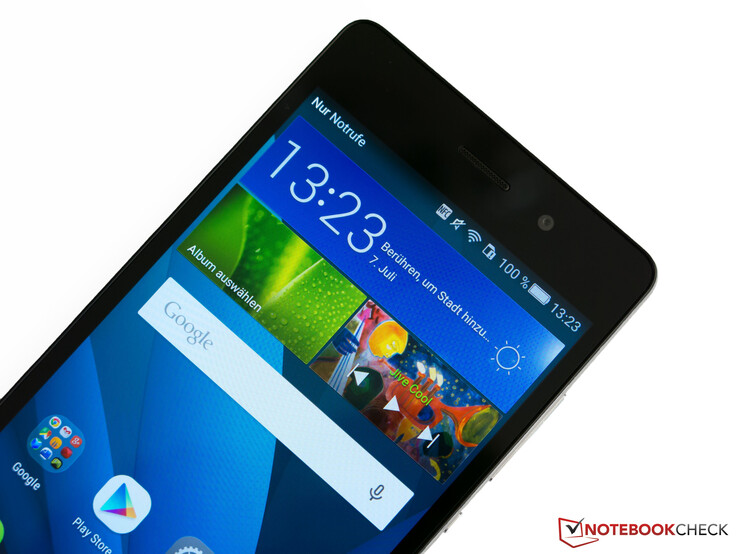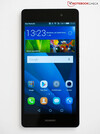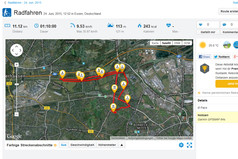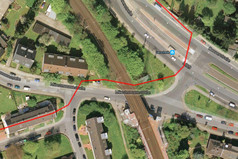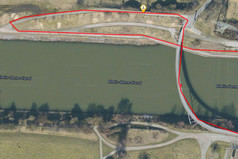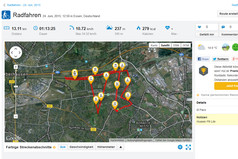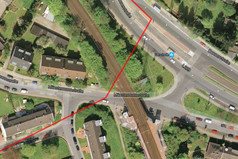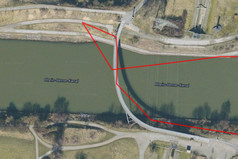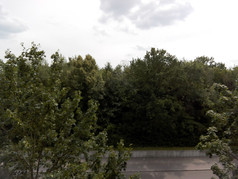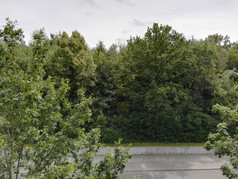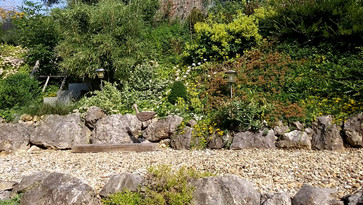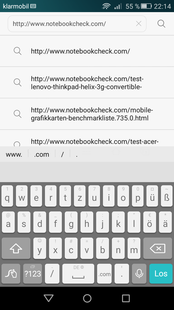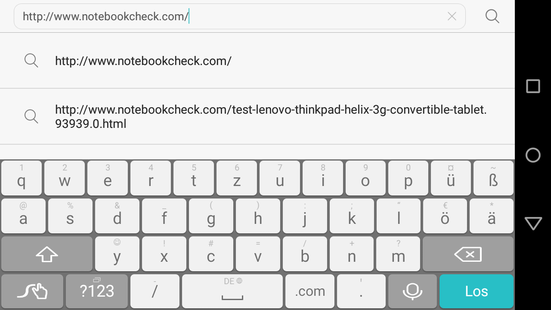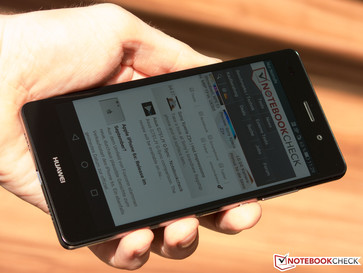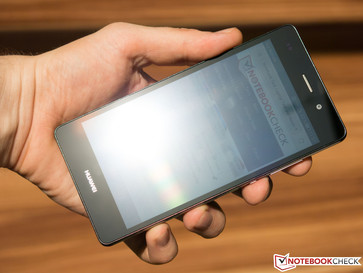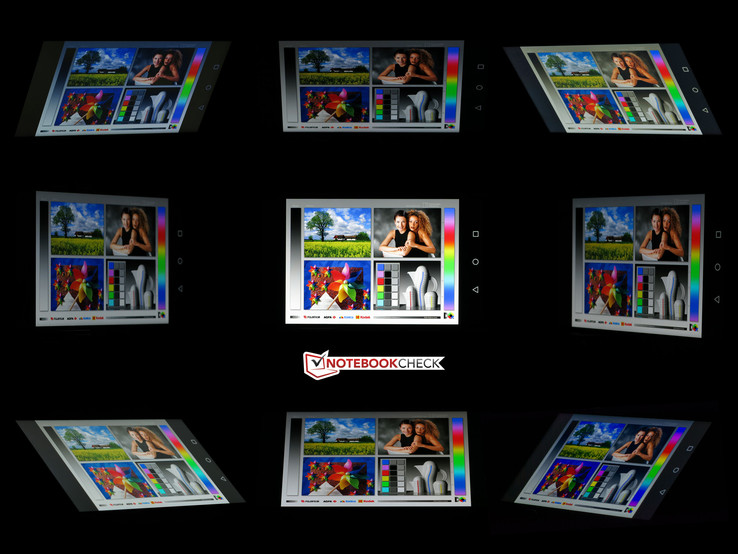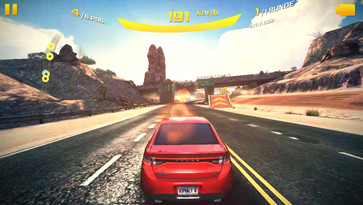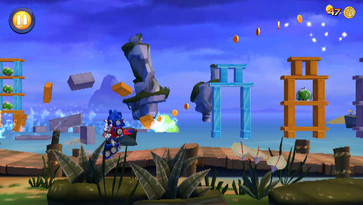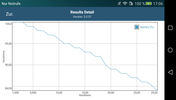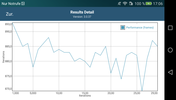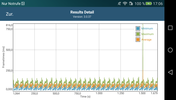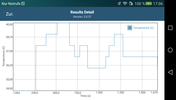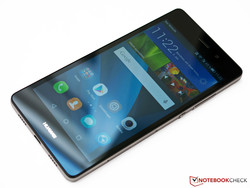Huawei P8 lite Smartphone Review

For the original German review, see here.
Huawei’s new mainstream smartphone P8 lite is the slimmed-down version of the high-end model P8 that we have already reviewed. Compared to the predecessor, the Ascend P7 mini, the display size of the P8 lite was increased from 4.5 to 5-inches and is therefore just slightly smaller than the 5.2-inch screen of the flagship. The class difference is mainly noticeable in respect to the resolution (Full HD vs. HD) as well as the clock of the octa-core SoC. However, the less expensive P8 lite supports dual-SIM and therefore has an advantage over the more expensive P8 that is available in Germany. Both devices use the same operating system Android 5.0 Lollipop. The new model retails for around 230 Euros (~$253) and therefore costs half of the bigger sibling. Our review will show whether the P8 lite is a bargain or if potential buyers have to live with too many compromises.
The price range between 180 and 240 Euros (~$190 and ~$264) is filled with rivals for the P8 lite. Besides Samsung's Galaxy Grand Prime as well as ZTE's Blade S6, there is the 4X from Honor, Huawei’s secondary brand and therefore a competitor from the same company. If you prefer another operating system, you should have a look at the Lumia 735 with Microsoft Windows.
Case
Contrary to the much more expensive P8, the P8 lite does not use an aluminum unibody, but the build quality of the case is still convenient. Small and even gaps as well as comfortable rounded corners support the good first impression, and the materials appear to be sophisticated as well.
While the front is completely covered by glass, this material is only used for the area around the camera as well as the LED flash at the back. Huawei uses grippy plastic for the rest of the chassis, which is nice to look at thanks to the fine stripes, a slight glitter effect and the matte texture, but it easily attracts fingerprints. Less convenient is also the fact that the review unit showed signs of abrasions on the back after a couple of days, even though we were very careful. This was noticeable because the surface was shinier at this spot under the light.
On the sides is a surrounding metal stripe with a brushed metal look, which also accommodates the buttons on the right side of the case.
At 7.7 millimeters, the P8 lite is slightly thicker than the P8 at 6.4 mm, but this is still a very good value compared to its direct rivals. The weight of 131 g is also lower than many 5-inch smartphones. The device does not have a detachable back cover, which means the user cannot replace the battery. The general stability of the case is okay, but it cannot compete with unibody constructions: You can hear creaking when you twist it, and a lot of pressure will create picture distortions on the display. All in all, the design of the P8 lite leaves a good impression and it also feels good in the hand at the same time.
Connectivity
The connectivity of the P8 lite is decent for a mainstream device. Huawei uses its own HiSilicon Kirin 620 SoC that only runs at 1.2 GHz, but it has eight cores in return. You also get 2 GB RAM as well as 16 GB eMMC flash storage. It is possible to expand the storage via microSD card. The maximum supported size of the SD card is 32 GB according to the specs, but a microSDXC card with a capacity of 64 GB worked fine in our review. It is also handy that apps can be transferred to the SD card, so there should not be any problems with the 16 GB storage, even though you can only use around 10 GB for your own files ex-works. One highlight is the dual-SIM feature of the smartphone (main card Micro-SIM, secondary card Nano-SIM). The secondary slot does, however, also work as the microSD slot, which means you cannot use both.
Unfortunately, the integrated Micro-USB 2.0 port neither supports OTG for the attachment of external devices nor MHL. The smartphone does, however, support media streaming to corresponding devices via Wi-Fi. NFC is integrated as well, which is still not a matter of course in this price range. You also get a multi-colored LED for notifications, which is typical for Android devices, but you cannot adjust its behavior with the preloaded software.
Software
The operating system of the P8 lite is Android 5.0 with Huawei’s customized user interface EMUI 3.1. This waives the otherwise common app drawer, so that all installed apps are displayed on the home screen. It is possible to create folders so it does not get too crowded, and it is even possible to scroll inside the folders when they consist of more than 9 apps.
The reworked user interface also introduces other improved details. This includes, among others, the optional "double tap to wake" feature as well as handy shortcuts on the lock screen that can be shown with a swipe from the bottom of the screen. The launching of certain apps (audio recorder, calculator, flashlight, camera) even works without unlocking the smartphone. Another way for quick access is the gesture control, where drawing certain letters on the deactivated screen will launch previously assigned apps.
There is also an alternative user interface for less experienced users, where the goal is to reduce the features to the most important things: Very big control elements are easier to use but still allow the access to the most important smartphone functions.
Besides the phone manager with optimization and administrative features that is already familiar from older devices, Huawei’s software package also includes third-party apps like Facebook and Twitter as well as several demos of games. The latter can be deleted if necessary. The innovative Director’s mode of the more expensive sibling P8 is not available for the P8 lite.
Communication & GPS
The wireless radio of the Huawei P8 lite covers all the common local GSM, 3G and LTE bands. There is no criticism for the signal quality, either, which was always comparable to other devices in this price range in the Vodafone network.
The integrated Wi-Fi module, unfortunately, only supports 802.11 b/g/n, so it does not work with 5 GHz networks. The signal quality in the 2.4 GHz band can convince us in return: We still had a working connection even with two walls in a building made of reinforced concrete between the router and the smartphone. The device also supports NFC as well as Bluetooth, but only the older standard 4.0 (Huawei P8: Bluetooth 4.1).
The P8 lite quickly locates the current position outdoors, but it does not always work indoors: While the smartphone was not able to establish a satellite connection on the third floor in a building with a total of four floors when we moved away from the windows, it was no problem to get a signal in a single-floor supermarket.
A more practical test of the P8 lite is the use as a tracking device on a predefined track that we compare with a professional navigation device Garmin GPSMAP 64s. While the smartphone determines a track length of 13.11 km, the device from Garmin only shows 11.12 km. This big deviation of almost 18% is caused by two things. There is a clear outlier on the track of the P8 lite that creates a wrong waypoint, but the GPS data acquisition of the smartphone is less precise in general. The most western waypoint in particular shows big deviations from the actual track. You will not be happy with the P8 lite if you need a precise navigation device. A positive aspect, however, is the pretty quick satellite fix outdoors.
Telephone & Voice Quality
The simple phone app has the usual number pad and also the common features like contacts, a chronological history with the design of the notification center as well as direct access to messages.
Voices were easy to understand on both sides of calls: Both participants found the sound to be pretty natural and free of background noises. This does not really change for the recipient when we use the hands-free functionality and we are still easy to understand. The speaker of the P8 lite does, however, tend to distort at high volumes, which also affects the sound. The voice of the caller sounded a bit unnatural via the provided headset, but the microphone worked well. All in all, the smartphone leaves a very good impression in this section.
Cameras
The P8 lite is equipped with a 13 MP main camera as well as a 5 MP selfie cam at the front. This means the technical specifications are similar to the rivals Honor 4X and ZTE Blade S6, while Samsung's Galaxy Grand Prime and Nokia's Lumia 735 have sensors with fewer pixels.
The technical basis of the main camera differs from the more expensive sibling P8 despite the identical resolution and the same aperture (f/2.0). The P8 lite only uses a normal RGB sensor instead of the newer RGBW version in the top model, and the mainstream smartphone does not have an optical image stabilizer and only a single-colored LED flash. Contrary to the German manufacturer’s website, the maximum resolution is not 4160x2336, but 4160x3120 pixels (4:3 aspect ratio). The default setting is, however, 16:9, which means the picture is cropped.
The picture quality is actually convincing, especially when you consider the price class. The sharpness and the details cannot compete with the high-end model Samsung Galaxy S6 under daylight but still convinces with a homogeneous and natural picture impression, even though the colors are sometimes a bit cold. A handy feature is the automatic HDR function, which also saves an additional picture with an enhanced dynamic range. Bad lighting situations (Scene 3), however, show a clear lack of details, which is probably caused by the aggressive noise suppression. The focusing of the camera was quick enough, even though not as quick as the LG G3 with a laser auto focus, which was used as a comparison device.
The webcam at the front should be well-suited for selfies with 5 MP (2592x1944 pixels), and you should also benefit from the large angle of the lens (35 mm format, equivalent to focal length of 22 mm). The quality can obviously not compete with the main camera – details are blurrier, colors are less accurate and picture noise is visible sooner. It is still good enough for occasional snapshots.
It is also handy that you can use the volume rocker as a trigger, zoom or focus button, which means it is possible to take pictures without using the touchscreen, for instance. The P8 lite also supports a feature to take pictures directly from standby, so you will not miss any moments. You just have to press the volume-down button twice pretty quickly when the smartphone is in standby – the first picture is taken around 1.5 seconds later. The only drawback of this solution is the deactivated auto focus, which is not perfect for macro shots.
It is possible to use several effects directly on the live picture in the camera app, so the results will get a special look. Some functions are, however, reserved for the P8 like Light Painting, Super-Night mode as well as the Director’s mode. Another issue is that you cannot use the flash when the battery capacity is low. We think that this decision should be made by the user.
Besides pictures, the two cameras can obviously also record videos. While the main camera supports resolutions up to 1920x1080 pixels at 30 fps, the front camera is limited to 1280x720 at 30 fps – the German website from Huawei, unfortunately, lists the incorrect specs of the sibling P8, where the sensor at the front can record in Full HD at 27 fps. It is also possible to use live effects in the videos or create time lapses. Slow-motion videos or frame rates higher than 30 fps are not possible.
The Full HD videos of the main camera are okay when you consider the price of the smartphone and the quality should be sufficient for some video memories. The sharpness is not completely convincing, because details are noticeably blurred by the comparatively strong compression of the bit rate, especially during movements. This is also shown by the two screenshots below that we took from two sample videos, which were recorded with the review unit as well as an LG G3 under the same conditions. The vegetation in particular shows the lower sharpness of the video from the P8 lite.
Audio recordings are no problem for the smartphone, and even quiet sounds are captured without any annoying background noises.
Accessories
The visually appealing box of the smartphone includes a 5-Watt USB power adaptor including cable, a headset as well as a tool to open the two card slots of the device. You also get a printed quick-start guide.
The manufacturer itself does not offer any dedicated accessories for the P8 lite, but you can buy several smartwatches and a Bluetooth headset.
Warranty
Huawei grants a two-year warranty for its product, which cannot be extended.
Input Devices & Handling
The whole front of the P8 lite is covered by Gorilla Glass 3, which was completely scratch-resistant during our test and also provided good gliding capabilities for the fingers. The transition to the chassis is perceptible because of the slightly higher frame of the side parts, which has conveniently rounded edges. This means the glass has no contact when the smartphone is lying upside down on a flat surface and is therefore protected. The pressure points of the volume rocker as well as the power button are firm, but both were not perfectly integrated at our review unit, so they left a slightly wobbly impression.
The manufacturer lets you choose between the standard Android keyboard and the so called Huawei Swype keyboard. The latter is activated by default and has some advantages like the direct input of German umlauts, for example, an adjustable keyboard height as well as several gesture controls. One drawback might be the spacebar, which is pretty hard to reach due to its small size, especially in landscape mode.
The generally very low response times of the device ensure a smooth user experience: Preloaded apps launch quickly, animations are smooth and the rotation of the display is almost immediate. Touchscreen inputs are precisely executed as well.
Display
The Huawei P8 lite uses a 5.0-inch IPS display with a 16:9 aspect ratio, which has a resolution of 1280x720 pixels that results in a typical pixel density of around 294 PPI. This is not overwhelming anymore since some top models already use QHD panels, but it ensures a sufficiently sharp presentation of content. Only the much more expensive sibling P8 has a higher resolution in this comparison, while the Samsung Galaxy Grand Prime even has fewer pixels.
A maximum brightness of 365 cd/m² is not really good and the P8 lite falls behind many rivals. Only the Nokia Lumia 735 has an even lower luminance, but it can compensate for that by the high-contrast AMOLED display. However, the even brightness distribution of the review unit is excellent at 93%, which surpasses all comparison devices.
| |||||||||||||||||||||||||
Brightness Distribution: 93 %
Center on Battery: 365 cd/m²
Contrast: 869:1 (Black: 0.42 cd/m²)
ΔE ColorChecker Calman: 5.2 | ∀{0.5-29.43 Ø4.77}
ΔE Greyscale Calman: 5.85 | ∀{0.09-98 Ø5}
91.25% sRGB (Argyll 1.6.3 3D)
70.86% AdobeRGB 1998 (Argyll 1.6.3 3D)
Gamma: 2.17
CCT: 7252 K
| Huawei P8 lite 1280 x 720 px 5.0'' (IPS) | Samsung Galaxy Grand Prime 960 x 540 px 5.0'' (TFT) | ZTE Blade S6 1280 x 720 px 5.0'' (IPS) | Honor 4X 1280 x 720 px 5.5'' (IPS) | Nokia Lumia 735 1280 x 720 px 4.7'' (AMOLED) | Huawei P8 1920 x 1080 px 5.2'' (IPS-NEO) | |
|---|---|---|---|---|---|---|
| Screen | ||||||
| Brightness middle (cd/m²) | 365 | 426 17% | 386 6% | 522 43% | 291 -20% | 453 24% |
| Brightness (cd/m²) | 353 | 415 18% | 377 7% | 514 46% | 293 -17% | 439 24% |
| Brightness Distribution (%) | 93 | 90 -3% | 90 -3% | 89 -4% | 93 0% | 91 -2% |
| Black Level * (cd/m²) | 0.42 | 0.83 -98% | 0.44 -5% | 0.62 -48% | 0.28 33% | |
| Contrast (:1) | 869 | 513 -41% | 877 1% | 842 -3% | 1618 86% | |
| Colorchecker dE 2000 * | 5.2 | 5.98 -15% | 7.12 -37% | 6.36 -22% | 4.04 22% | 4.7 10% |
| Greyscale dE 2000 * | 5.85 | 6.03 -3% | 6.7 -15% | 6.51 -11% | 2.87 51% | 5.03 14% |
| Gamma | 2.17 101% | 2.48 89% | 1.98 111% | 2.17 101% | 2.49 88% | 2.27 97% |
| CCT | 7252 90% | 7983 81% | 7784 84% | 8044 81% | 6432 101% | 7439 87% |
| Color Space (Percent of AdobeRGB 1998) (%) | 70.86 | 72.04 2% | ||||
| Color Space (Percent of sRGB) (%) | 91.25 |
* ... smaller is better
The Huawei P8 lite manages a black value of 0.42 cd/m² and can beat many rivals. This also means that the smartphone, despite the comparatively low maximum brightness, manages a good contrast ratio of 869:1, which is a typical result for this product class. The picture is subjectively very natural and does not cause any criticism.
We use the software CalMAN and a spectrophotometer for further analysis and determine DeltaE deviations of 5.2 (ColorChecker) and 5.85 (Grayscale), respectively. These values cannot quite keep up with high-end devices, but they are very decent among this comparison group. Only the Nokia Lumia 735 with its AMOLED panel manages more accurate colors. Even the NEO-IPS display in the sibling P8, which is superior in many respects, only manages slightly better values. The color temperature is slightly raised at 7,252 K, but it is still closer to the ideal value of 6,500 K than many other rivals. The color-space coverage of the P8 lite is also almost on par with the much more expensive P8.
The P8 lite has a disadvantage outdoors because of its pretty low display brightness. Still, the visibility is pretty good on a bright day when you can avoid direct sunlight. The situation can be improved a bit by the option "Improve Visibility under Sunlight," which provides stronger contrasts.
The viewing-angle stability of the IPS display is decent, but it cannot keep up with the NEO IPS panel of the Huawei P8 or the AMOLED screen of the Nokia Lumia 735. A bit annoying is the slight yellow hue when you look at the display from an angle above (left) or below (right). The other two directions resulted in a shift towards cooler colors, and very flat viewing angles even resulted in slight inversions in dark areas. However, these deviations are no problem when you shift along the horizontal or vertical axis, so the viewing-angle stability should be sufficient for most users in practice.
Performance
The P8 lite is equipped with Huawei’s own HiSilicon Kirin 620 SoC. It has 8 cores that are clocked at 1.2 GHz each and based on a 64-bit architecture. This means the device has a high multi-core performance on paper, but the performance of a single core should be less overwhelming due to the comparatively low clock.
This effect is easily visible in Geekbench 3, where the P8 lite falls behind the ZTE Blade S6 by 15% in the single-core test. The Blade S6 uses a fast quad-core clocked at 1.7 GHz, while four more cores of the Qualcomm 615 octa-core SoC are much slower at 1.0 GHz. The situation changes in the multi-core test, where the benefits of the higher clocks for the ZTE Blade S6 are smaller, and the P8 lite even manages an advantage of 20%. The P8 lite generally leaves a good impression in respect of the CPU performance compared to the rivals.
The Kirin 620 SoC uses the integrated GPU Mali-450 MP4, which has problems against the Adreno 405 GPU in the ZTE Blade S6. 3DMark (2013) as well as the GFXBench T-Rex benchmark show that the latter is more than 50% faster. The slower GPUs of the Nokia Lumia 735 as well as the Samsung Galaxy Grand Prime, however, are beaten by the P8 lite. Open GL 3.0 is not supported by the Mali-450 MP4 GPU, which is why we could not perform the Manhattan benchmark of GFXBench 3.0.
| AnTuTu v5 - Total Score (sort by value) | |
| Huawei P8 lite | |
| Honor 4X | |
| ZTE Blade S6 | |
| Huawei P8 | |
| Geekbench 3 | |
| 64 Bit Multi-Core Score (sort by value) | |
| Huawei P8 lite | |
| Honor 4X | |
| ZTE Blade S6 | |
| Huawei P8 | |
| 64 Bit Single-Core Score (sort by value) | |
| Huawei P8 lite | |
| Honor 4X | |
| ZTE Blade S6 | |
| Huawei P8 | |
| Smartbench 2012 | |
| Gaming Index (sort by value) | |
| Huawei P8 lite | |
| Honor 4X | |
| ZTE Blade S6 | |
| Huawei P8 | |
| Productivity Index (sort by value) | |
| Huawei P8 lite | |
| Honor 4X | |
| ZTE Blade S6 | |
| Huawei P8 | |
| PCMark for Android - Work performance score (sort by value) | |
| Huawei P8 lite | |
| ZTE Blade S6 | |
| Huawei P8 | |
| GFXBench (DX / GLBenchmark) 2.7 | |
| T-Rex Onscreen (sort by value) | |
| Huawei P8 lite | |
| Honor 4X | |
| ZTE Blade S6 | |
| Nokia Lumia 735 | |
| Huawei P8 | |
| 1920x1080 T-Rex Offscreen (sort by value) | |
| Huawei P8 lite | |
| Honor 4X | |
| ZTE Blade S6 | |
| Nokia Lumia 735 | |
| Huawei P8 | |
| 3DMark | |
| 1280x720 offscreen Ice Storm Unlimited Score (sort by value) | |
| Huawei P8 lite | |
| Honor 4X | |
| ZTE Blade S6 | |
| Samsung Galaxy Grand Prime | |
| Huawei P8 | |
| 1280x720 offscreen Ice Storm Unlimited Graphics Score (sort by value) | |
| Huawei P8 lite | |
| Honor 4X | |
| ZTE Blade S6 | |
| Samsung Galaxy Grand Prime | |
| Huawei P8 | |
| 1280x720 offscreen Ice Storm Unlimited Physics (sort by value) | |
| Huawei P8 lite | |
| Honor 4X | |
| ZTE Blade S6 | |
| Samsung Galaxy Grand Prime | |
| Huawei P8 | |
The P8 lite leaves mixed impressions in the browser benchmarks. It usually beats the rivals from Nokia and Samsung as well as the Honor 4X with the same SoC, but the ZTE Blade S6 and the much more expensive Huawei P8 are clearly faster. A bit surprising is the comparatively bad result in SunSpider, which was determined with Google Chrome because the stock browser stopped the test with an error message.
| Octane V2 - Total Score (sort by value) | |
| Huawei P8 lite | |
| Honor 4X | |
| ZTE Blade S6 | |
| Samsung Galaxy Grand Prime | |
| Nokia Lumia 735 | |
| Huawei P8 | |
| Sunspider - 1.0 Total Score (sort by value) | |
| Huawei P8 lite | |
| Honor 4X | |
| ZTE Blade S6 | |
| Samsung Galaxy Grand Prime | |
| Nokia Lumia 735 | |
| Huawei P8 | |
| Mozilla Kraken 1.1 - Total (sort by value) | |
| Huawei P8 lite | |
| Honor 4X | |
| ZTE Blade S6 | |
| Samsung Galaxy Grand Prime | |
| Nokia Lumia 735 | |
| Huawei P8 | |
| WebXPRT 2015 - Overall (sort by value) | |
| Huawei P8 lite | |
| Huawei P8 | |
| Google V8 Ver. 7 - Google V8 Ver. 7 Score (sort by value) | |
| Huawei P8 lite | |
| Honor 4X | |
| ZTE Blade S6 | |
| Nokia Lumia 735 | |
| Huawei P8 | |
* ... smaller is better
The integrated eMMC storage of the P8 lite convinces in AndroBench 3 with good transfer rates for read and write operations. Our review unit is at the top in almost every test, and it is only just beaten by the Honor 4X in the 4K read test. It is also surprising that even the high-end model P8 falls behind in respect of the sequential write performance.
| AndroBench 3-5 | |
| Random Write 4KB (sort by value) | |
| Huawei P8 lite | |
| Honor 4X | |
| ZTE Blade S6 | |
| Samsung Galaxy Grand Prime | |
| Huawei P8 | |
| Random Read 4KB (sort by value) | |
| Huawei P8 lite | |
| Honor 4X | |
| ZTE Blade S6 | |
| Samsung Galaxy Grand Prime | |
| Huawei P8 | |
| Sequential Write 256KB (sort by value) | |
| Huawei P8 lite | |
| Honor 4X | |
| ZTE Blade S6 | |
| Samsung Galaxy Grand Prime | |
| Huawei P8 | |
| Sequential Read 256KB (sort by value) | |
| Huawei P8 lite | |
| Honor 4X | |
| ZTE Blade S6 | |
| Samsung Galaxy Grand Prime | |
| Huawei P8 | |
Games
The Huawei P8 lite is equipped with a Mali-450 MP4 GPU. We already saw that it cannot keep up with the best chips in this class in the benchmarks, but the performance is still sufficient for current mobile games.
The smartphone managed smooth gameplay in the visually demanding racing game Asphalt 8 with normal settings and created a realistic impression of speed. There were no huge stutters even with high details, but the frame rate took a noticeable hit. The precise touchscreen and the accurate sensors worked very well. Other games like Angry Birds Transformers are no problem for the P8 lite.
One issue during gaming is the unfavorable position of the speaker on the lower part of the right chassis side, where it can easily be covered by the hand. The only solution is to turn the device by 180 degrees.
Emissions
Temperature
Our review unit is always warmer than the rivals while idling, and the situation is similar under load. Only the ZTE Blade S6 with its powerful octa-core SoC gets a bit warmer. The temperatures are not critical by any means, but you hold a smartphone in your hands, so maximum values of 40 °C are clearly perceptible. It is strange that the more powerful sibling P8 with its thin aluminum case is even cooler under load than the P8 lite while idling.
The GFXBench battery test, which repeats the T-Rex Onscreen benchmark thirty times, shows if the hardware components lose performance after periods of sustained load. We can see that the P8 lite can only utilize its full performance at the beginning of the test, but the deficits are not too bad at 2.6% over the course of the test. This means the performance of the P8 lite is pretty steady in the stress test.
(±) The maximum temperature on the upper side is 40.2 °C / 104 F, compared to the average of 35.2 °C / 95 F, ranging from 21.9 to 247 °C for the class Smartphone.
(±) The bottom heats up to a maximum of 41.1 °C / 106 F, compared to the average of 34 °C / 93 F
(±) In idle usage, the average temperature for the upper side is 33.2 °C / 92 F, compared to the device average of 32.9 °C / 91 F.
Speaker
Even though there are two grilles at the bottom of the smartphone, which would suggest a dual-speaker system, there is actually just one speaker at the left side. It can create a comparatively balanced sound up to a maximum volume of around 60%, and there is even some bass. Higher volumes, however, will quickly affect the quality: Music sounds distorted and scratchy, and the sound spectrum is shifted towards higher tones. A medium setting is, fortunately, sufficient for quieter environments, and the maximum setting can be reserved for louder situations, where there are other noises anyway. The situation is similar for the hands-free feature, where you should waive the maximum volume in favor of better understandability.
The provided headset gets the job done but will not be very convincing for music enthusiasts with its muffled and unnatural sound. The performance via 3.5 mm stereo jack, however, is very good when you use better headphones.
Energy Management
Power Consumption
The P8 lite stands out from the masses in respect of the power consumption – but, unfortunately, not in a good way. All the mainstream rivals except for the ZTE Blade S6 need less power, and even the high-end device P8 with a fast octa-core processor as well as a bigger Full HD screen is up to 50% more frugal while idling. It is also striking that the Honor 4X with the same SoC and a bigger and brighter screen is more frugal under load with the maximum brightness settings. The latter was still running Android 4.4.2 at the time of the review, which could cause some discrepancies. An argument against that is, however, that Android Lollipop should actually be more frugal.
A complete charge of the empty battery takes about 2 hours and 40 minutes with the 5-Watt PSU when the device is turned on but inactive.
| Off / Standby | |
| Idle | |
| Load |
|
Key:
min: | |
| Huawei P8 lite Mali-450 MP4, Kirin 620, 16 GB eMMC Flash | Samsung Galaxy Grand Prime Adreno 306, 410 MSM8916, 8 GB eMMC Flash | ZTE Blade S6 Adreno 405, 615 MSM8939, 16 GB eMMC Flash | Honor 4X Mali-450 MP4, Kirin 620, 8 GB eMMC Flash | Nokia Lumia 735 Adreno 305, 400 MSM8926, 8 GB eMMC Flash | Huawei P8 Mali-T628 MP4, Kirin 930, 16 GB eMMC Flash | |
|---|---|---|---|---|---|---|
| Power Consumption | ||||||
| Idle Minimum * (Watt) | 1.4 | 0.4 71% | 1.6 -14% | 0.8 43% | 0.6 57% | 0.7 50% |
| Idle Average * (Watt) | 2.3 | 0.9 61% | 2.5 -9% | 1.7 26% | 1.4 39% | 2 13% |
| Idle Maximum * (Watt) | 2.5 | 1.1 56% | 2.8 -12% | 2 20% | 1.9 24% | 2.1 16% |
| Load Average * (Watt) | 3.9 | 2.9 26% | 5.5 -41% | 3.6 8% | 2.6 33% | 4.9 -26% |
| Load Maximum * (Watt) | 6 | 3.5 42% | 6.3 -5% | 5.5 8% | 3.6 40% | 7.4 -23% |
* ... smaller is better
Battery Runtime
The comparatively high consumption figures already indicated that the battery runtimes of the P8 lite are comparatively short in all scenarios. It is therefore not surprising that the smartphone only manages 5 hours and 51 minutes in our realistic Wi-Fi test, which is the worst result in our comparison group. The situation is similar for almost every other scenario; only the power-hungry ZTE Blade S6 has less stamina under load. Our review unit is pretty much on par with the Honor 4X in the video playback test, but the bigger sibling P8 lasts around three-and-a-half hours longer. The P8 lite has an ultra-energy-saving mode for emergency situations, which can increase the runtime a bit. You should, however, use it wisely, since all functions of the smartphone are reduced to calls and text messages.
Despite this mediocre stamina, the battery is usually sufficient to manage a whole day with occasional usage of the smartphone. In our experience, the smartphone still had 50% capacity remaining after 12 hours in this scenario with activated wireless modules and activated synchronization.
| Huawei P8 lite Mali-450 MP4, Kirin 620, 16 GB eMMC Flash | Samsung Galaxy Grand Prime Adreno 306, 410 MSM8916, 8 GB eMMC Flash | ZTE Blade S6 Adreno 405, 615 MSM8939, 16 GB eMMC Flash | Honor 4X Mali-450 MP4, Kirin 620, 8 GB eMMC Flash | Nokia Lumia 735 Adreno 305, 400 MSM8926, 8 GB eMMC Flash | Huawei P8 Mali-T628 MP4, Kirin 930, 16 GB eMMC Flash | |
|---|---|---|---|---|---|---|
| Battery runtime | ||||||
| Reader / Idle (h) | 11.9 | 16.4 38% | 15.4 29% | 18.4 55% | 18.5 55% | 13.8 16% |
| H.264 (h) | 6.2 | 8.3 34% | 6.2 0% | 10.7 73% | 9.7 56% | |
| WiFi v1.3 (h) | 5.9 | 8.5 44% | 7.2 22% | 9.5 61% | 7.2 22% | |
| Load (h) | 3.2 | 2.5 -22% | 4.5 41% | 5 56% | 3.6 13% | |
| WiFi (h) | 12.7 |
Pros
Cons
Verdict
Buyers of the P8 lite get a solid device that convinces with a smooth operation, good voice quality and a decent screen in practice. The chassis leaves a good and pretty sophisticated impression in general as well, even though the build quality reveals some small flaws like the wobbly buttons. The slimmed-down smartphone lacks some features of the high-end sibling P8, but nothing important is missing. Quite the contrary: The optional dual-SIM feature is only available on the P8 lite in some countries, but you should be aware that you cannot expand the memory via microSD card when you use two SIM cards.
The P8 lite is also a good choice for people who like to take photos, and the picture quality is particularly convincing compared to the rivals. The Ultra-Snapshot feature directly from standby is also a handy feature. It is also possible to record Full HD videos.
What might be more annoying for potential buyers are the short battery runtimes, the inaccurate GPS module as well as the mediocre sound quality of the headset. The display brightness could be higher as well, even though we always found a position where the screen content was easy to see.
Huawei’s P8 lite for 230 Euros (~$253) is a good device for users that are looking for a good price-performance ratio, without making too many compromises in respect of the usability.
Huawei P8 lite
- 07/18/2015 v4 (old)
Andreas Kilian


